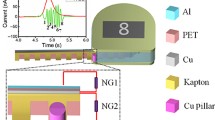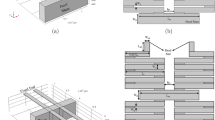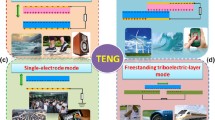Abstract
Recently, triboelectric generator (TEG) has attracted a lot of attention due to its high output voltage and low-cost fabrication rocess. Here, a novel cubic TEG box is designed, which has separated electrodes on different surfaces. Thanks to the specially designed structure, it can scavenge vibration energy from all directions. Firstly the device is investigated through finite element method (FEM) simulation. Then the device is evaluated by experiments. The measuremental results show that this device can generate an amount of 25 nC charge during once shake by charging a 10 nF capacitor. Besides, an output voltage about 100 V is obtained, which is able to directly light up several light-emitting diodes (LEDs) simultaneously. At last, the device is utilized as a self-powered orientation sensor, which shows explicit directivity. This work extends the applications of TEG for ambient vibration energy harvesting techniques and the self-powered orientation sensor.
Similar content being viewed by others
References
Han M D, Zhang X S, Liu W, et al. Low-frequency wide-band hybrid energy harvester based on piezoelectric and triboelectric mechanism. Sci China Tech Sci, 2013, 56: 1835–1841
Zhang Y J, Yang Y, Zhang Y. Theoretical study of electric energy consumption for self-powered chaos signal generator. Sci China Tech Sci, 2014, 57: 1063–1067
Liu W, Han M D, Meng B, et al. Low frequency wide band-width MEMS energy harvester based on spiral-shaped PVDF cantilever. Sci China Tech Sci, 2014, 57: 1068–1072
Huang X, Li L J, Zhang Y. Modeling the open circuit output voltage of piezoelectric nanogenerator. Sci China Tech Sci, 2013, 56: 2622–2629
Han M D, Liu W, Zhang X S, et al. Investigation and characterization of an arc-shaped piezoelectric generator. Sci China Tech Sci, 2013, 56: 2636–2641
Wang Z L, Song J H. Piezoelectric nanogenerators based on zinc oxide nanowire arrays. Science, 2006, 312: 242–246
Chen X, Xu S Y, Yao N, et al. 1.6 V nanogenerator for mechanical energy harvesting using PZT nanofibers. Nano Lett, 2010, 10: 2133–2137
Lin L, Hu Y F, Xu C, et al. Transparent flexible nanogenerator as self-powered sensor for transportation monitoring. Nano Energy, 2013, 2: 75–81
Leng Q, Chen L, Guo H Y, et al. Harvesting heat energy from hot/cold water with a pyroelectric generator. J Mater Chem A, 2014, 2: 11940–11947
Yang Y, Wang S H, Zhang Y, et al. Pyroelectric nanogenerators for driving wireless sensors. Nano Lett, 2013, 12: 6408–6413
Han M D, Qiu G L, Liu W, et al. A cubic electromagnetic harvester that convert vibration energy from all directions. Rev Sci Instrum, 2014, 85: 076109
Lin L, Wang S H, Niu S M, et al. Noncontact free-rotating disk triboelectric nanogenerator as a sustainable energy harvester and selfpowered mechanical sensor. ACS Appl Mater Interfaces, 2014, 6: 3031–3038
Lin L, Wang S H, Xie Y N, et al. Segmentally structured disk triboelectric nanogenerator for harvesting rotational mechanical energy. Nano Lett, 2013, 13: 2916–2923
Niu S M, Wang S H, Lin L, et al. Theoretical study of contact-mode triboelectric nanogenerators as an effective power source. Energy Environ Sci, 2013, 6: 3576–3583
Niu S M, Liu Y, Wang S H, et al. Theory of sliding-mode triboelectric nanogenerators. Adv Mater, 2013, 25: 6184–6193
Wang S H, Xie Y N, Niu S M, et al. Freestanding triboelectric-layerbased nanogenerators for harvesting energy from a moving object or human motion in contact and non-contact modes. Adv Mater, 2014, 26: 2818–2824
Yang Y, Zhu G, Zhang H L, et al. Triboelectric nanogenerator for harvesting wind energy and as self-powered wind vector sensor system. ACS Nano, 2013, 7: 9461–9468
Yang Y, Zhang H L, Liu R Y, et al. Fully enclosed triboelectric nanogenerators for applications in water and harsh environments. Adv Energy Mater, 2013, 3: 1563–1568
Fan F R, Tian Z Q, Wang Z L. Flexible triboelectric generator!. Nano Energy, 2012, 1: 328–334
Yang Y, Zhou Y S, Zhang H L, et al. Single-electrode based triboelectric nanogenerator as self-powered tracking system. Adv Mater, 2013, 25: 6594–660
Zhang H L, Yang Y, Su Y J, et al. Triboelectric nanogenerator for harvesting vibration energy in full space and as self-powered acceleration sensor. Adv Funct Mater, 2014, 24: 1401–1407
Zhang C, Tang W, Han C B, et al. Theoretical comparison, equivalent transformation, and conjunction operations of electromagnetic induction generator and triboelectric nanogenerator for harvesting mechanical energy. Adv Mater, 2014, 26: 3580–3591
Author information
Authors and Affiliations
Corresponding author
Additional information
Contributed equally to this work.
Rights and permissions
About this article
Cite this article
Qiu, G., Liu, W., Han, M. et al. A cubic triboelectric generator as a self-powered orientation sensor. Sci. China Technol. Sci. 58, 842–847 (2015). https://doi.org/10.1007/s11431-015-5790-7
Received:
Accepted:
Published:
Issue Date:
DOI: https://doi.org/10.1007/s11431-015-5790-7




